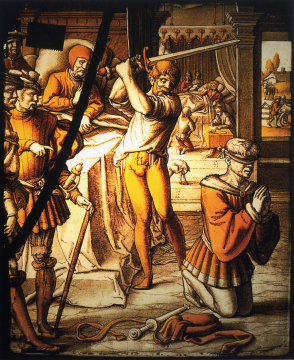Explore Collections


You are here:
CollectionsOnline
/
The Judgement of William the Good, stained glass panel, Workshop of Dirck Pietersz. Crabeth, Netherlandish, c.1540
Browse
The Judgement of William the Good, stained glass panel, Workshop of Dirck Pietersz. Crabeth, Netherlandish, c.1540
Clear glass with brown paint, light and dark yellow stain
Height: 240mm
Width: 195mm
Width: 195mm
Museum number: SG24
On display: Staircase - adjacent to the Picture Room, ground floor to basement
All spaces are in No. 13 Lincoln's Inn Fields unless identified as in No. 12, Soane's first house.
For tours https://www.soane.org/your-visit
Curatorial note
The subject is a pseudo-historical event of 1336, published in 1517 as an example of 'strictness'. Didactic scenes like these were commonly employed during this period to convey a moral. In this example a bailiff stole a farmer’s well-fed cow and replaced it with an emaciated beast (scene far right). The farmer then complained to Count William III of Holland, who was ill in bed in Valencienne (scene centre background). The Count commanded the bailiff to appear, ordered him to pay the farmer 100 crowns and then ordered the executioner to behead the bailiff (main scene).
Several later engravings of the scene are known, including 1606 after Wtewael, 1613 after Blockland and 1627 after Dolendo. It is also the subject of a lost painting by Swanenburgh, commissioned for Leiden Town Hall in 1582, of which Buytewech made a series of drawings in 1618. There are many later versions (see Moelands and Smidt).
Popham attributed the panel to Jan Swart (subject unknown), and the format together with the overall style, such as the meticulous drawing of the composition and the use of yellow stain for precisely defined areas, is typical of Swart’s work. However Berserik has pointed out the refinement of facial details characteristic of the work of Dirck Pietersz. Crabeth of Gouda. Crabeth was at first much influenced by Swart, and may have been his pupil. This panel is therefore likely to be an early work of Crabeth’s workshop.
Several later engravings of the scene are known, including 1606 after Wtewael, 1613 after Blockland and 1627 after Dolendo. It is also the subject of a lost painting by Swanenburgh, commissioned for Leiden Town Hall in 1582, of which Buytewech made a series of drawings in 1618. There are many later versions (see Moelands and Smidt).
Popham attributed the panel to Jan Swart (subject unknown), and the format together with the overall style, such as the meticulous drawing of the composition and the use of yellow stain for precisely defined areas, is typical of Swart’s work. However Berserik has pointed out the refinement of facial details characteristic of the work of Dirck Pietersz. Crabeth of Gouda. Crabeth was at first much influenced by Swart, and may have been his pupil. This panel is therefore likely to be an early work of Crabeth’s workshop.
Literature
A. E. Popham’s comments are MS notes in pencil held at Sir John Soane’s Museum, c. 1930.
F. W. H. Hollstein, Dutch and Flemish etchings, engravings and woodcuts ca. 1450-1700. Amsterdam: Rijksmusem, 1949– V, 259, XXIX, 56.
Timothy B. Husband, The Luminous Image, Painted Glass Roundels in the Lowlands, 1480-1560. New York: Metropolitan Museum, 1995.
Dr C. J. Berserik, correspondence. Sir John Soane's Museum Archive (1998-2002).
M. A. Moelands and J. Th. de Smidt, ‘Weegschool en Zwaard’, De Verbielding van Recht en Gerechtijheid in Nederland. The Hague: Royal Library, 1999.
Catalogue of the Stained Glass in Sir John Soane's Museum, Special Issue of the Journal of Stained Glass 2004, pp 160-161
F. W. H. Hollstein, Dutch and Flemish etchings, engravings and woodcuts ca. 1450-1700. Amsterdam: Rijksmusem, 1949– V, 259, XXIX, 56.
Timothy B. Husband, The Luminous Image, Painted Glass Roundels in the Lowlands, 1480-1560. New York: Metropolitan Museum, 1995.
Dr C. J. Berserik, correspondence. Sir John Soane's Museum Archive (1998-2002).
M. A. Moelands and J. Th. de Smidt, ‘Weegschool en Zwaard’, De Verbielding van Recht en Gerechtijheid in Nederland. The Hague: Royal Library, 1999.
Catalogue of the Stained Glass in Sir John Soane's Museum, Special Issue of the Journal of Stained Glass 2004, pp 160-161
Soane collections online is being continually updated. If you wish to find out more or if you have any further information about this object please contact us: worksofart@soane.org.uk

